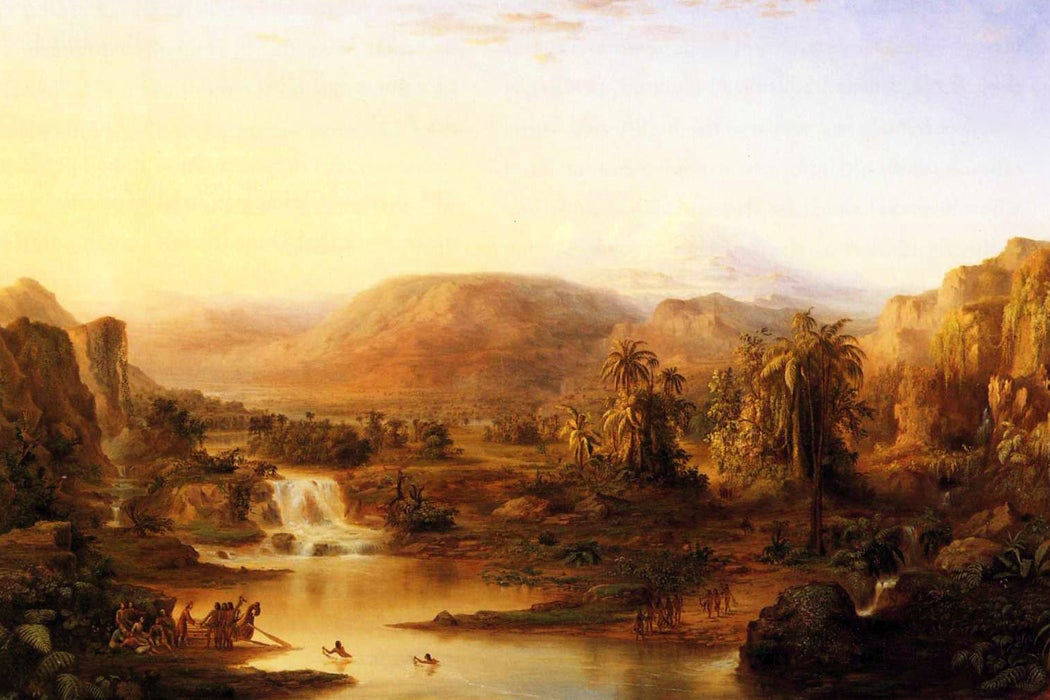Beneath a stretch of grass in Monroe, Michigan’s Historic Woodland Cemetery is the grave of a leading nineteenth-century landscape painter who was among the first African American artists to gain international fame. Robert S. Duncanson’s work hangs in the Smithsonian American Art Museum, the Detroit Institute of Arts (DIA), and the National Gallery of Art. And yet here at his final resting place, his grave has remained unmarked since he died in 1872.
Born in 1821 into a free black family in Seneca County, New York, Duncanson later moved to the Midwest, living in Cincinnati and Detroit. “Duncanson began his career as a housepainter and taught himself art by copying engravings of European masterpieces,” writes art historian Lisa E. Farrington in Source: Notes in the History of Art. “The combined forces of abolitionist support and the artist’s own talents and perseverance led to a highly successful career for the painter as an interpreter of romantic landscapes within the context of the Hudson River school.”
He worked in what became known as the Ohio River Valley style, influenced by the landscapes of the Hudson River school painters like Thomas Cole and Frederic Church. While he also created portraits and still lifes, it was these luminous landscapes that got the most acclaim. When he traveled to Europe with the backing of an abolitionist organization, he found himself drawn to English romanticism, and instilled the realism of his landscapes with a pastoral sublimity.
“By the end of the 1850s, after nearly two decades of artistic struggles, Duncanson had become an accomplished landscape painter who could express a broad range of sentiment and formal qualities,” writes art historian Joseph D. Ketner II in The American Art Journal. He also had his own impact on nineteenth century art, particularly when he moved to Montréal during the Civil War and inspired the emerging Canadian school of landscape art.
And yet, Duncanson’s name became obscure after his death, perhaps because he does not fit a neat narrative. Many of his supporters were abolitionists, such as James Francis Conover who commissioned his 1853 “Uncle Tom and Little Eva” (one of Duncanson’s only works to directly address slavery). But Duncanson himself was not an activist. He was a black artist in the United States at a time of slavery, yet he did not actively engage with race or oppression in his paintings.
Get Our Newsletter
What Duncanson was passionate about was painting. As art historian Wendy J. Katz notes, on June 29, 1871 he “wrote a letter in response to his son’s accusation that Duncanson had tried to pass for white. By that point in his career, Duncanson had achieved renown as an artist, or, as he said, a fame ‘second to none’ in the United States.” He affirmed to his son that “my heart has always been with the down-trodden race,” and concluded: “Mark what I say here in black and white: I have no color on the brain, all I have on the brain is paint … I care not for color: ‘Love is my principle, order is the basis, progress is the end’.”
Duncanson has not been totally forgotten; Columbia University’s Wallach Art Gallery hosted a survey of his work in 2012. And as for his unmarked grave, that will soon change. As the Detroit Free Press reports, Monroe resident Dora Kelley has led a group of local artists and art patrons in a grassroots fundraising campaign to commission a marker. A black granite tombstone with Duncanson’s name and an etching of his 1871 “Ellen’s Isle, Loch Katrine,” on view at the nearby DIA, will be installed at his family plot by the end of the year.







